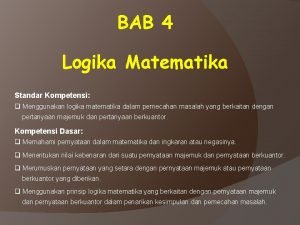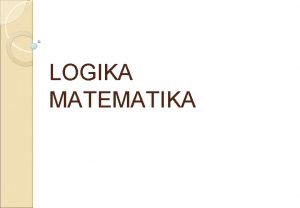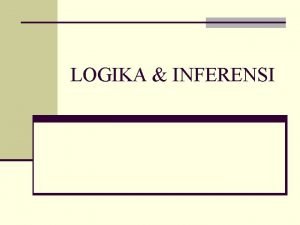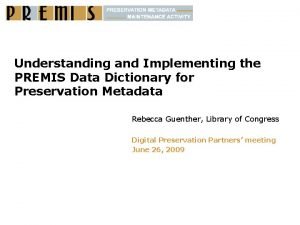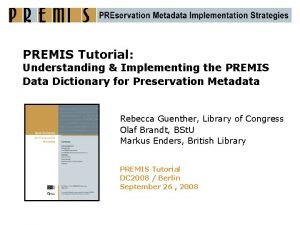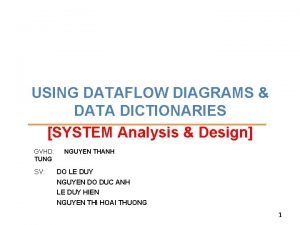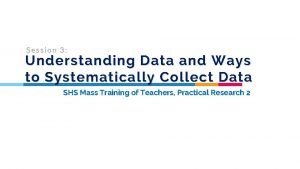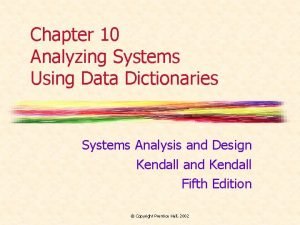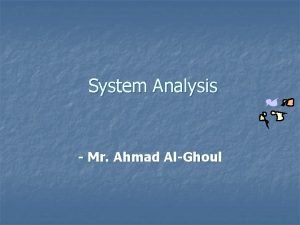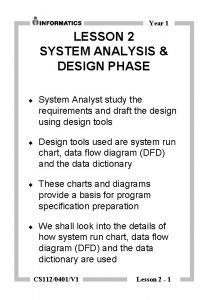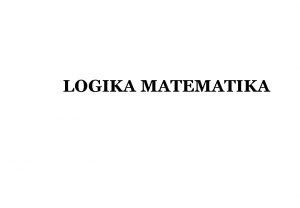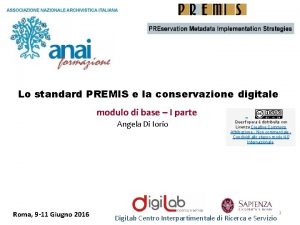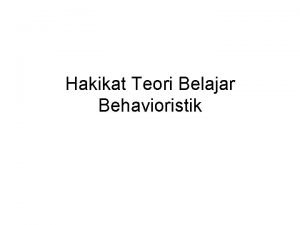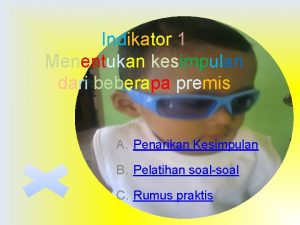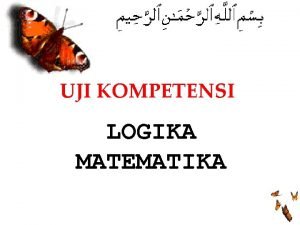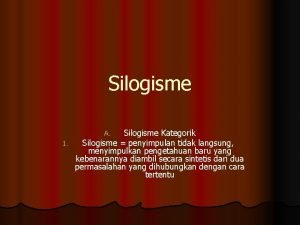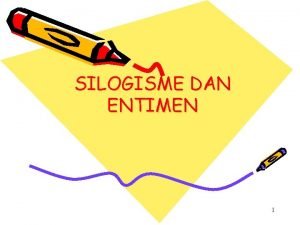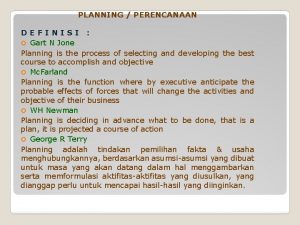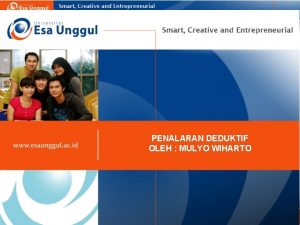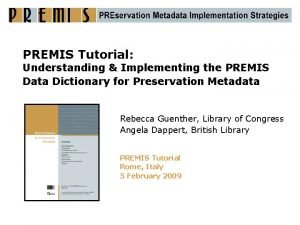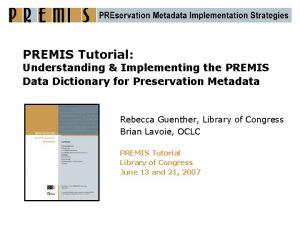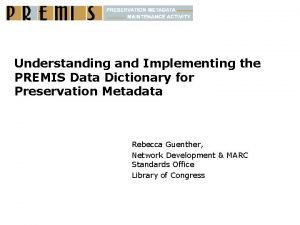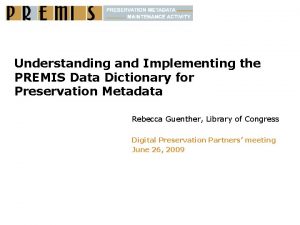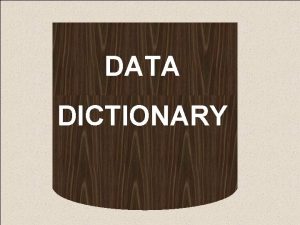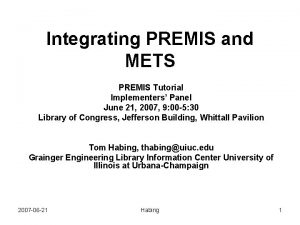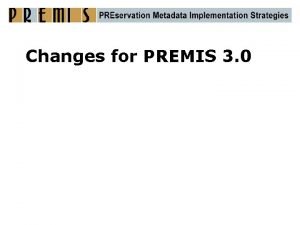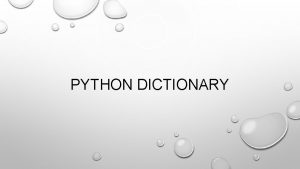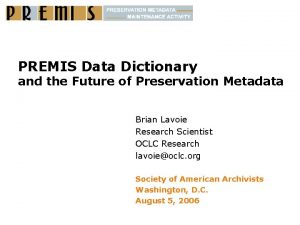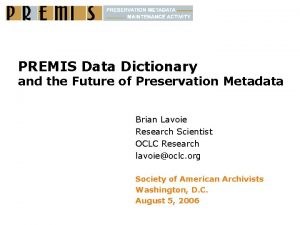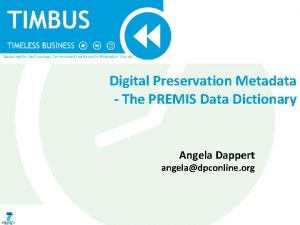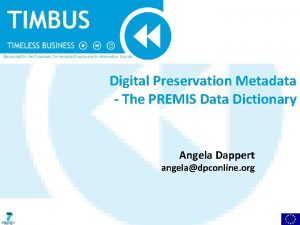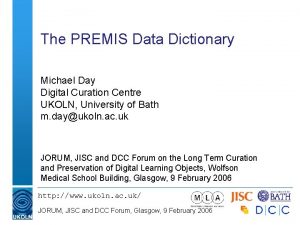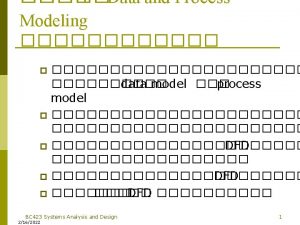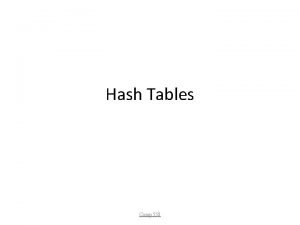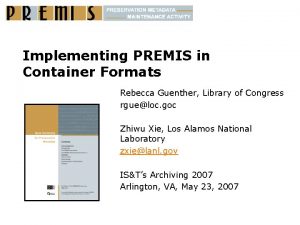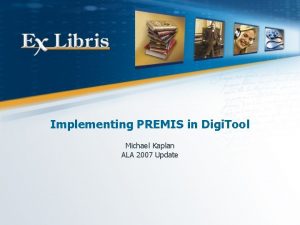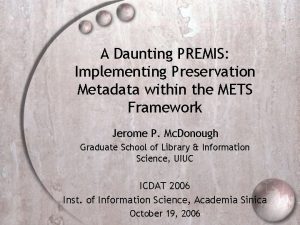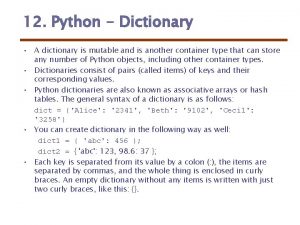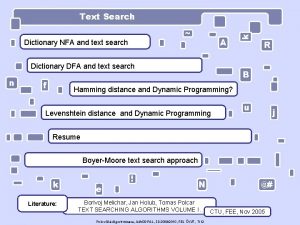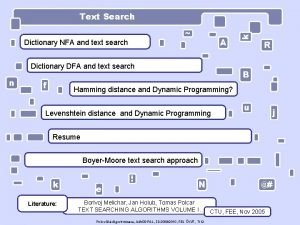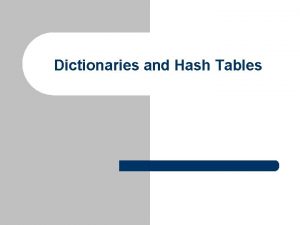Understanding and Implementing the PREMIS Data Dictionary for






























- Slides: 30

Understanding and Implementing the PREMIS Data Dictionary for Preservation Metadata Rebecca Guenther, Library of Congress Digital Preservation Partners’ meeting June 26, 2009

Overview § § § What is preservation metadata? PREMIS development and goals Introduction to the PREMIS data dictionary PREMIS Maintenance Agency Implementing PREMIS

Preservation Metadata Preservation metadata includes: § § Provenance: • Who has had custody/ownership of the digital object? Content Authenticity: • Is the digital object what it purports to be? 10 years on 50 years on § Preservation Activity: • What has been done to preserve it? § Technical Environment: • What is needed to render and use it? § Rights Management: • What IPR must be observed? Ø Makes digital objects self-documenting across time Forever!

PREMIS Working Group § June 2003: OCLC, RLG sponsored international working group: • § PREMIS: Preservation Metadata: Implementation Strategies Membership: > 30 experts from 5 countries, representing libraries, museums, archives, government agencies, and the private sector • Co-Chairs: Priscilla Caplan (FCLA), Rebecca Guenther (LC) • § Objective 1: Identify and evaluate alternative strategies for encoding, storing, managing, and exchanging preservation metadata PREMIS Survey Report (September 2004) • Snapshot of current practices/emerging trends related to managing and using preservation metadata in digital archiving systems • http: //www. oclc. org/research/projects/pmwg/surveyreport. pdf • § Objective 2: Define implementable, core preservation metadata, with guidelines/recommendations for management and use

PREMIS Data Dictionary § May 2005: Data Dictionary for Preservation Metadata: Final Report of the PREMIS Working Group § March 2008: PREMIS Data Dictionary for Preservation Metadata, version 2. 0 § Includes PREMIS Data Dictionary, context/assumptions, data model, usage § XML schema to support implementation § Data Dictionary: examples Comprehensive view of information needed to support digital preservation • Guidelines/recommendations to support creation, use, management • Based on deep pool of institutional experiences in setting up and managing operational capacity for digital preservation • http: //www. loc. gov/standards/premis/v 2/premis-2 -0. pdf

2005 British Conservation Awards: Digital Preservation Award 2006 Society of American Archivists Preservation Publication Award

Some guiding principles … § “Implementable, core, preservation metadata”: “Preservation metadata”: maintain viability, renderability, understandability, authenticity, identity in a preservation context • “Core”: What most preservation repositories need to know to preserve digital materials over the long-term • “Implementable”: rigorously defined; supported by usage guidelines/recommendations; emphasis on automated workflows • § “Technical neutrality”: Digital archiving system: no assumptions about specific archiving technology, system/DB architectures, preservation strategy • Metadata management: no assumptions about whether metadata is stored locally or in external registry; recorded explicitly or known implicitly; instantiated in one metadata element or multiple elements • Promotes flexibility, applicability in wide range of contexts •

What does PREMIS cover? § Administrative metadata that supports the digital preservation process § Provides information to help manage a resource for preservation purposes Technical characteristics • Information about actions on an object • Relationships (structural and derivative) • Structural: indicates how compound objects are put together • Derivative: results of common preservation actions • Rights metadata associated with preservation § In OAIS terms: • Metadata as part of SIP, AIP or DIP • Fits into Preservation Description Information (Reference, Context, Provenance, Fixity) § Understanding PREMIS by Priscilla Caplan: an introduction to the PREMIS data dictionary http: //www. loc. gov/standards/premis/understanding-premis. pdf •

What PREMIS is and is not § What PREMIS is: Common data model for organizing/thinking about preservation metadata • A checklist for core metadata in a repository • Guidance for local implementations • Standard for exchanging information packages between repositories • § What PREMIS is not: Out-of-the-box solution: need to instantiate as metadata elements in repository system • All needed metadata: excludes business rules, format-specific technical metadata, descriptive metadata for access, non-core preservation metadata • Lifecycle management of objects outside repository • Rights management: limited to permissions regarding actions taken within repository •

PREMIS Data Model Intellectual Entities Rights Statements Agents Objects Events

Intellectual Entities § Examples: § Rabbit Run by John Updike (a book) § “Maggie at the beach” (a photograph) § The Library of Congress Website (a website) § The Library of Congress: American Memory Home page (a web page) § § § Set of content that is considered a single intellectual unit for purposes of management and description (e. g. , a book, a photograph, a map, a database) May include other Intellectual Entities (e. g. a website that includes a web page) **Has one or more digital representations** Not fully described in PREMIS DD, but can be linked to in metadata describing digital representation

Objects § § § Discrete unit of information in digital form **Objects are what repository actually preserves** Three types of Object: FILE: named and ordered sequence of bytes that is known by an operating system • REPRESENTATION: set of files, including structural metadata, that, taken together, constitute a complete rendering of an Intellectual Entity • BITSTREAM: data within a file with properties relevant for preservation purposes (but needs additional structure or reformatting to be standalone file) • Examples: § chapter 1. pdf (a file) § chapter 1. pdf + chapter 2. pdf + chapter 3. pdf (representation of a book w/3 chapters) § TIFF file containing header and 2 images (2 bitstreams (images), each with own set of properties (semantic units): e. g. , identifiers, technical metadata, inhibitors, … )

Object Example: book in two versions Intellectual Entity Da Vinci Code by Dan Brown Representation 1 Page image version File 1: page 1. tiff File 2: page 2. tiff File N: page. N. tiff Representation 2 ebook version File N+1: METS. xml File 1: book. lit

Events § § Examples: § Validation Event: use JHOVE tool to verify that chapter 1. pdf is a valid PDF file § Ingest Event: transform an OAIS SIP into an AIP § Migration Event: create a new version of an Object in an up-to-date format § An action that involves or impacts at least one Object or Agent associated with or known by the preservation repository Helps document digital provenance. Can track history of Object through the chain of Events that occur during the Objects lifecycle Determining which Events are in scope is up to the repository (e. g. , Events which occur before ingest, or after de-accession)

event. Type § § Names the event From a controlled vocabulary Could use coded values Granularity is implementationspecific Capture Compression Deaccession Decompression Decryption Deletion Dig. signature validation Dissemination Fixity check Ingestion Message digest calculation Migration Normalization Replication Validation Virus check

Agents § § Examples: § Priscilla Caplan (a person) § Florida Center for Library Automation (an organization) § Dark Archive in the Sunshine State implementation (a system) § JHOVE version 1. 0 (a software program) § Person, organization, or software program/system associated with an Event or a Right (permission statement) Agents are associated only indirectly to Objects through Events or Rights Not defined in detail in PREMIS DD; not considered core preservation metadata beyond identification

Rights Statements § § Example: § Priscilla Caplan grants FCLA digital repository permission to make three copies of metadata_fundamentals. pdf for preservation purposes. An agreement with a rights holder that grants permission for the repository to undertake an action(s) associated with an Object(s) in the repository. Not a full rights expression language; focuses exclusively on permissions that take the form: • Agent X grants Permission Y to the repository in regard to Object Z.

Semantic units pertaining to objects: technical metadata § § § object. Identifier preservation. Level significant. Properties object. Category object. Characteristics • fixity • size • format • creating. Application • inhibitors • extension original. Name storage environment signature. Information relationship linking. Event. ID linking. Intellectual Entity. ID § linking. Rights Statement. ID § § § §

Semantic units pertaining to Events: provenance and preservation activity § § § § event. Identifier event. Type event. Date. Time event. Detail event. Outcome. Detail linking. Agent. Identifier linking. Object. Identifier

Semantic units pertaining to Rights · rights. Statement · · · rights. Statement Identifier rights. Basis copyright. Information license. Information statute. Information · rights. Granted act · restriction · term. Of. Grant · rights. Granted · linking. Object. Identifier · linking. Agent. Identifier · rights. Extension ·

Semantic units pertaining to Agents § agent. Identifier § agent. Name § agent. Type

Recent/planned enhancements § Extensions • Extensibility added in version 2. 0 • Allows for more granular metadata developed externally to be contained within PREMIS, e. g. XML signatures, format specific metadata schemes, environment information, other rights schemas § Controlled vocabularies • Allows for machine processing • Sharing controlled vocabularies will benefit implementers • Some semantic units in the DD suggest defining them • id. loc. gov will make them available in the future

Community interest § PREMIS Data Dictionary product of collaboration and consensus PREMIS implementations reflect a variety of institutions, domains, countries • Multiplicity of perspectives promotes applicability in multiplicity of contexts • Digital preservation is a shared problem; this invites shared solutions • § Data Dictionary useful to any institution or organization committed to the long-term preservation of digital materials

PREMIS Maintenance Activity § Web site: Permanent Web presence, hosted by Library of Congress • Central destination for PREMIS-related info, announcements, resources • Home of the PREMIS Implementers’ Group (PIG) discussion list • § PREMIS Editorial Committee: Set directions/priorities for PREMIS development • Coordinate future revisions of Data Dictionary and XML schema • Promote implementation • Membership: Library of Congress, OCLC, FCLA, British Library, Library and Archives Canada, BSt. U (Germany), MIT/Dspace, Ex. Libris • http: //www. loc. gov/standards/premis/

Activities § Guidelines for using PREMIS with METS (draft available at: ) • http: //www. loc. gov/premis/guidelines-premismets. html § PREMIS Implementers’ Registry • http: //www. loc. gov/premis-registry. html § PREMIS tutorials and meetings: Past tutorials: Glasgow, Boston, Stockholm, Albuquerque, Washington, San Diego, Rome • PREMIS Implementation Fair: Oct. 7, 2009 (i. Pres 2009) • § PREMIS conformance work § Tool for converting PREMIS to METS to PREMIS and vice versa § Tool for extracting metadata and populating in PREMIS XML

A few implementers … § § DAITTSS (Florida): a preservation repository for the use of the libraries of the public universities of Florida. Uses a locallydeveloped software application (DAITSS), which implements most of the PREMIS data elements. TIPR project: FCLA, Cornell, NYU § Ex Libris Rosetta: a digital preservation system that supports the acquisition, validation, ingest, storage, management, preservation and dissemination of different types of digital objects while enforcing the relevant policies that can vary from one institution to another. § British Library electronic journal archiving project: uses METS, MODS, PREMIS for information packages § For more information see: • http: //www. loc. gov/premis-registry. html

What does it mean to implement PREMIS? § Use the PREMIS data dictionary as information you need for preserving digital objects § There can be a phased approach to implementation in terms of which PREMIS entities/semantic units to implement § Some semantic units are not widely implemented (e. g. environment); registries may provide information in future § Most values can be extracted from the object or generated by a repository § You don’t have to control all 3 levels of objects; some may only manage files, not representations or bitstreams § If you aren’t already, you should be planning to track actions on objects for future preservation activities (PREMIS events) § Further work will clarify other aspects of PREMIS conformance

Implementing and participating in PREMIS § Consider your uses and storage models to determine how much of it to implement § Consider any business rules that apply to groups of digital objects § Consider using METS as a standard for exchange package with the PREMIS in METS guidelines § Join the PREMIS Implementers’ group and discuss issues list: http: //listserv. loc. gov/listarch/pig. html § Consider attending PREMIS Implementation Fair if you are implementing (details will be announced early July) § Watch for developing tools to facilitate implementation

Conclusions § PREMIS Data Dictionary provides critical piece of reliable digital preservation infrastructure comprised of technology, standards, and best practice § PREMIS was produced from an international, cross-domain, consensus-building process and is applicable to any preservation effort § PREMIS Data Dictionary is a building block with which effective, sustainable digital preservation strategies can be implemented § PREMIS Data Dictionary and the Maintenance Activity is tightly focused on implementation § PREMIS is being widely implemented and experience using it needs to be shared

URLs, etc. § PREMIS Maintenance Activity: http: //www. loc. gov/standards/premis/ § PREMIS Data Dictionary for Preservation Metadata: http: //www. loc. gov/standards/premis/v 2/premis-2 -0. pdf § PREMIS Implementation Registry http: //www. loc. gov/standards/premis-registry. php § PREMIS Implementers Group list http: //listserv. loc. gov/listarch/pig. html
 Dito mababasa ang pinakakaluluwa ng teksto
Dito mababasa ang pinakakaluluwa ng teksto Pernyataan berkuantor
Pernyataan berkuantor Premis premis adalah
Premis premis adalah Contoh kalimat dilema konstruktif
Contoh kalimat dilema konstruktif Contoh argumen yang valid
Contoh argumen yang valid Premis data dictionary
Premis data dictionary Premis data dictionary
Premis data dictionary Data dictionary example in system analysis and design
Data dictionary example in system analysis and design Understanding data and ways to systematically collect data
Understanding data and ways to systematically collect data Analyzing systems using data dictionaries
Analyzing systems using data dictionaries Data dictionary example in system analysis and design
Data dictionary example in system analysis and design What is data dictionary in system analysis and design
What is data dictionary in system analysis and design Chapter 7 strategic management
Chapter 7 strategic management Strategic management chapter 7
Strategic management chapter 7 Implementing strategies: management and operations issues
Implementing strategies: management and operations issues Tripod of pricing
Tripod of pricing Designing and implementing brand architecture strategies
Designing and implementing brand architecture strategies Designing and implementing brand architecture strategies
Designing and implementing brand architecture strategies Crm project design and planning process
Crm project design and planning process Matching structure with strategy
Matching structure with strategy Toyota brand architecture
Toyota brand architecture Implementing strategies management and operations issues
Implementing strategies management and operations issues Premis
Premis Premis standard
Premis standard Premis dasar teori behavioristik adalah interaksi antara
Premis dasar teori behavioristik adalah interaksi antara Rumus premis
Rumus premis Premis
Premis Silogisme kategorik
Silogisme kategorik Silogisme disjungtif
Silogisme disjungtif Premis perencanaan
Premis perencanaan Premis adalah
Premis adalah

